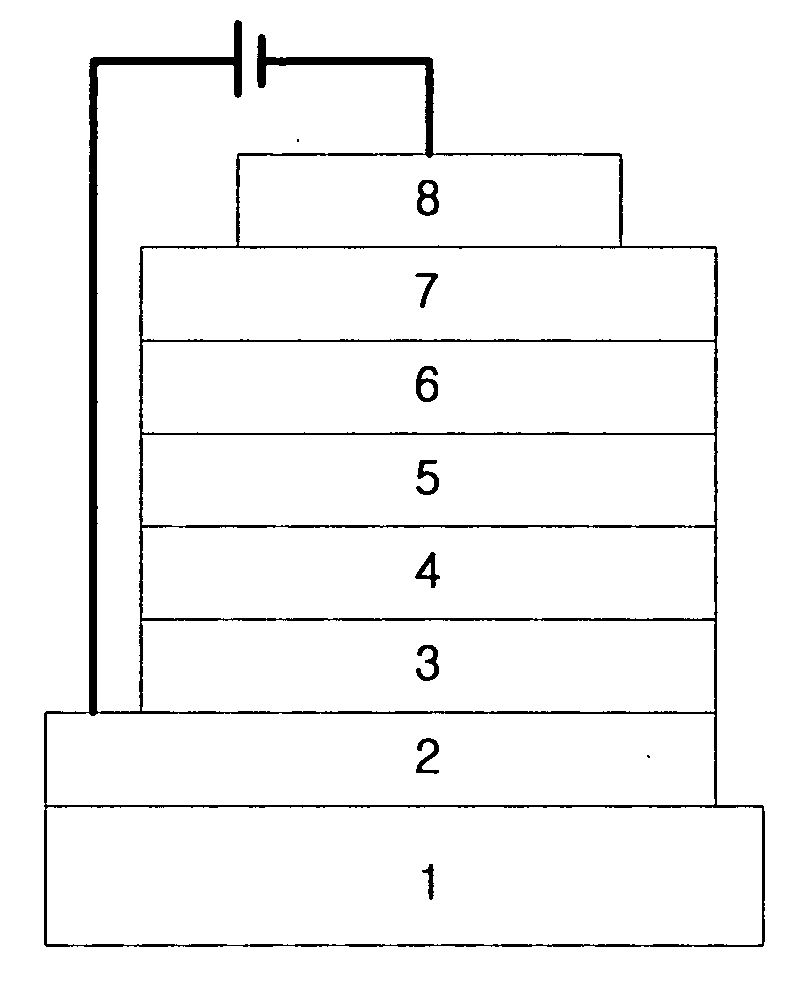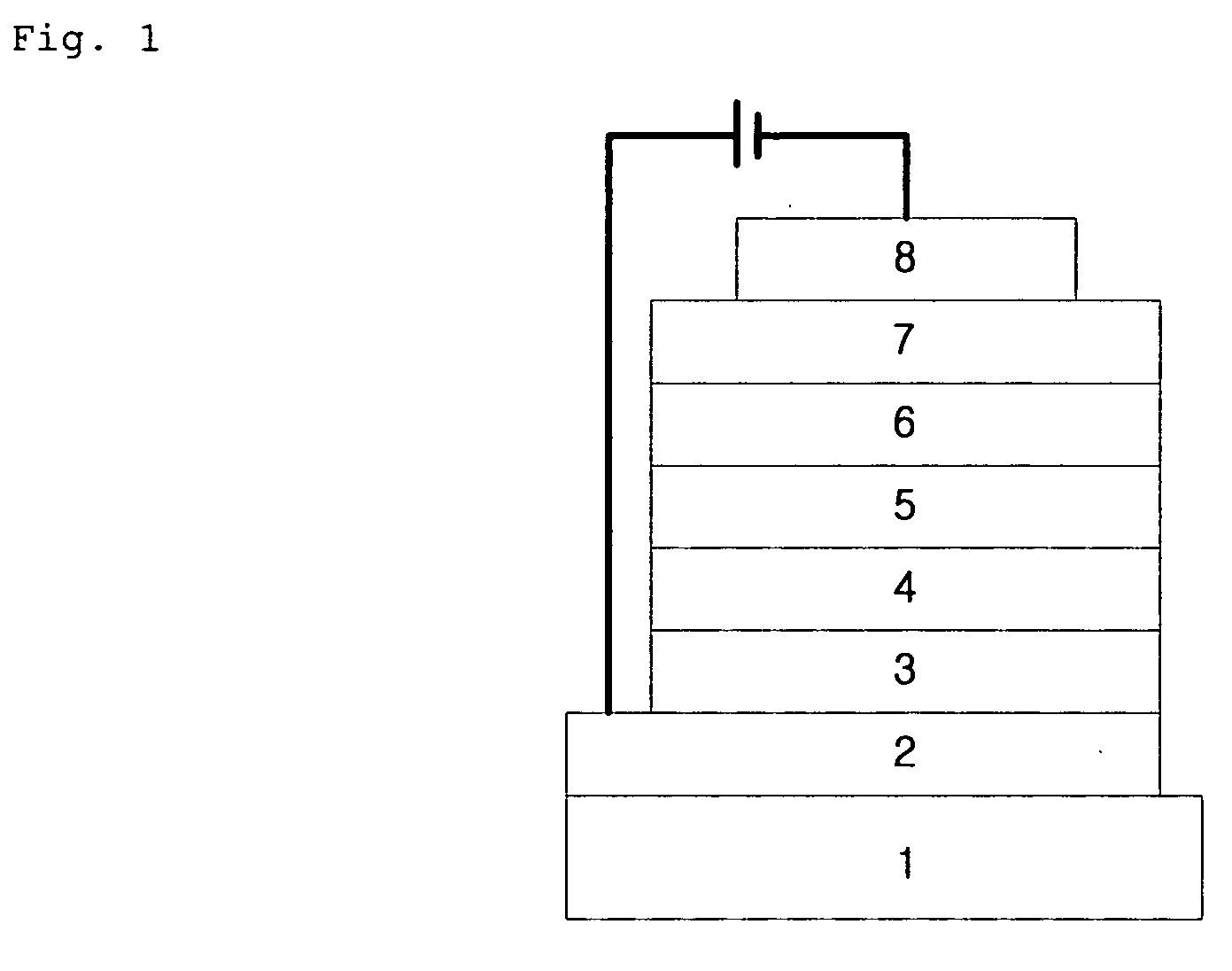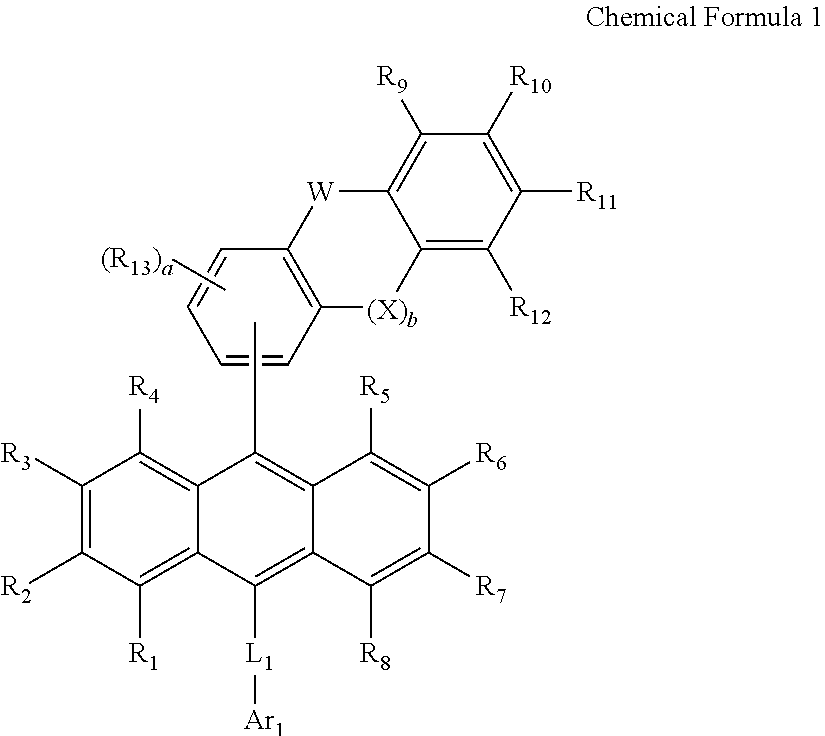Novel organic electroluminescent compounds and organic electroluminescent device using the same
- Summary
- Abstract
- Description
- Claims
- Application Information
AI Technical Summary
Benefits of technology
Problems solved by technology
Method used
Image
Examples
preparation examples
Preparation Example 1
Preparation of Compound (1493)
[0121]
[0122]Preparation of Compound (A)
[0123]In dimethyl sulfoxide (400 mL), dissolved were 2-bromofluorene (30.0 g, 122.0 mmol), potassium hydroxide (KOH) (41.2 g, 734.0 mmol), and the solution was cooled to 0° C. After slowly adding water, the mixture was stirred for 30 minutes. While maintaining the temperature at 0° C., methyl iodide (CH3I) (30.5 g, 489.0 mmol) was slowly poured into the mixture. Then the temperature was raised to room temperature, and the mixture stirred for 12 hours. After adding 10% hydrochloric acid (1 L), the resultant mixture was stirred for 10 minutes. Solid produced was filtered under reduced pressure, and recrystallized from hexane and methanol to obtain Compound (A) (29.5 g, 108.0 mmol).
[0124]Preparation of Compound (B)
[0125]Compound (A) (29.5 g, 108.0 mmol) was dissolved in purified tetrahydrofuran (350 mL) under nitrogen atmosphere. After chilling the solution to −78° C., n-butyllithium (n-BuLi, 2.5 ...
example 1
Manufacture of an OLED Employing Organic Electroluminescent Compound According to the Invention
[0139]An OLED device was manufactured by using an electroluminescent material according to the invention.
[0140]First, a transparent electrode ITO thin film (15Ω / □) (2) prepared from glass for OLED (produced by Samsung-Corning) (1) was subjected to ultrasonic washing with trichloroethylene, acetone, ethanol and distilled water, sequentially, and stored in isopropanol before use.
[0141]Then, an ITO substrate was equipped in a substrate folder of a vacuum vapor-deposit device, and 4,4′,4″-tris(N,N-(2-naphthyl)-phenylamino)triphenylamine (2-TNATA) was placed in a cell of the vacuum vapor-deposit device, which was then ventilated up to 10−6 torr of vacuum in the chamber. Electric current was applied to the cell to evaporate 2-TNATA, thereby providing vapor-deposit of a hole injecting layer (3) having 60 nm of thickness on the ITO substrate.
[0142]Then, to another cell of the vacuum vapor-deposit ...
example 2
Electroluminescent Properties of OLED's Manufactured
[0148]The luminous efficiencies of the OLED's comprising the organic electroluminescent compound according to the present invention (Examples 1) or conventional EL compound (Comparative Example 1) were measured at 5,000 cd / m2, respectively, and the results are shown in Table 2.
[0149]Since the electroluminescent properties in high luminance region are very important, particularly in case of green electroluminescent materials, the data at high luminance (about 20,000 cd / m2) are attached in order to reflect the properties.
TABLE 2LuminousefficiencyDoping(cd / A)concentration@5000 cd / No.HostDopant(mol %)m2Color13Compound E318.5Green2173Compound E318.9Green3285Compound E320.3Green4456Compound E318.2Green5567Compound E319.5Green6765Compound E319.7Green7892Compound E318.5Green81058Compound E319.6Green91087Compound E320.7Green101250Compound E321.8Green111381Compound E320.1Green121518Compound E318.3Green131710Compound E318.6Green141767Compound...
PUM
| Property | Measurement | Unit |
|---|---|---|
| Length | aaaaa | aaaaa |
| Length | aaaaa | aaaaa |
| Length | aaaaa | aaaaa |
Abstract
Description
Claims
Application Information
 Login to View More
Login to View More - R&D
- Intellectual Property
- Life Sciences
- Materials
- Tech Scout
- Unparalleled Data Quality
- Higher Quality Content
- 60% Fewer Hallucinations
Browse by: Latest US Patents, China's latest patents, Technical Efficacy Thesaurus, Application Domain, Technology Topic, Popular Technical Reports.
© 2025 PatSnap. All rights reserved.Legal|Privacy policy|Modern Slavery Act Transparency Statement|Sitemap|About US| Contact US: help@patsnap.com



